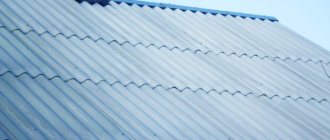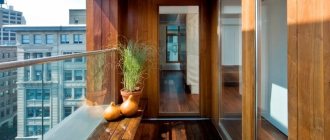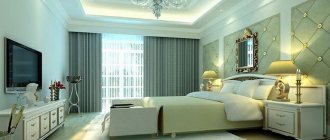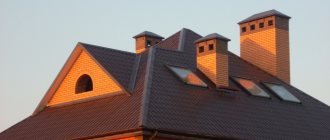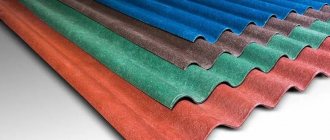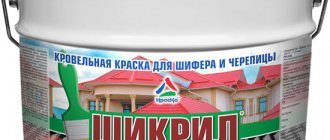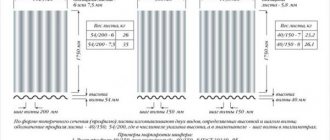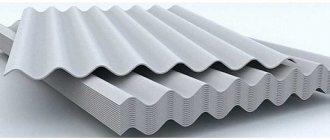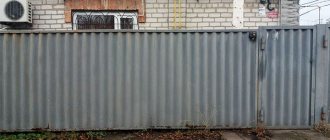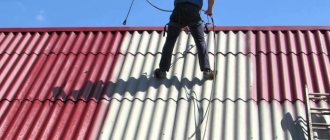Gardeners often use available materials to improve the area and make the plantings easy to process. Slate beds are found on almost every plot of land; they are easy to use, neat and accessible to all owners of gardens and vegetable gardens.
The design of beds made of flat slate is very simple and can be made with your own hands
Why should you use slate in landscape design?
When replacing the roof on a house, the old coating can be used in the garden. The material is used for fencing beds, cesspools, and when laying a foundation for a greenhouse. With original imagination, slate will not only bring benefits to the site, but will also decorate it.
Affordable price and durability are the main advantages of slate beds
There are two types of slate: wave and flat. To create beds, the sheets are cut to the required width and length and dug into the trench. When using wave material, there is no need for additional fastening of the sheets to each other; they are connected by two outer waves. Flat slate for garden beds requires additional fastening with metal plates and corners so that the fence does not move apart and stands evenly in place.
The wave structure of the material provides the slate with strength sufficient for constructing high beds
Flat slate is absolutely not inferior to wave slate in terms of moisture resistance and resistance to temperature changes
Also, for beds you can use both materials at the same time
The slate structure can be assembled in a few hours. The lightness and strength of the material make it possible to forget about the fence for a long time. It is not susceptible to rotting and moisture during watering and rain. The material heats up well in the sun and transmits heat into the ground, so when using high beds, yields increase.
Greenhouse with slate beds:
Tall structures are not flooded with water during excessive rainfall, and weed control is reduced to zero. The material does not grow mold, and insects that can damage the plantings do not live.
General recommendations
To successfully build beds, it is important to follow a few simple recommendations. The main ones include:
- correct location of beds;
- sufficient deepening of the fencing sheets;
- correct width of beds;
- correct organization of row spacing.
It is necessary to arrange the beds in such a way that they are mostly exposed to sunlight. This means that they should stretch from east to west. The correct width of the beds should not exceed 120 cm. This size is not a categorical rule, but such beds are easier to care for. In order for the slate sheets to withstand soil pressure, they must be buried 20 cm. The space between the beds should be sufficient for free movement. It can be laid out with paving slabs or covered with straw or sawdust. This will prevent weed growth and make it easier to move.
Features of using slate in a summer cottage
Advantages of slate:
- Availability. The cost of the material is low compared to other types of fencing. Often they use old slate, which is simply thrown away, giving it a second life.
- Diversity. The material is easily cut into the required pieces according to size. You can create any shape and configuration of beds. Small sections are used to lay out circles and polygons for flower beds, rectangles and squares for vegetable beds and berry beds.
- Any colour. Slate is easy to paint, you can make the fence multi-colored and add bright colors to the area. With the artistic skills of the owner, entire pictures are often drawn on the material. You can update the color scheme as desired each season.
Painting slate makes the beds much more attractive and significantly increases the service life of the fences.
Flat slate for beds looks less decorative than wave slate. But on a flat surface you can give free rein to your imagination and draw a masterpiece of fine art.
Slate is used not only for fences on the site, it is used to enclose front gardens or the lower part of a metal fence to prevent animals from entering.
When using high beds, the distance between them is filled with pebbles or sown with lawn grass. It looks very neat and aesthetically pleasing, and there is no dirt between the rows.
Arranging row spacing gives the site an attractive appearance and makes it easier to care for the plantings
Video: flower beds and beds made from plastic bottles
Photos of fences for garden beds
These are not all types of fencing - each owner can use his own imagination and skill. So that they are combined with the general appearance of the garden plot and are safe during operation. Have a nice summer!
How to treat the surface → Room decoration → How to choose the right paint → Surface treatment technologies → Leveling and finishing the walls → Selecting and applying a primer → Removal from the surface → Stretch ceilings and technologies → Reviews and testimonials
Popular materials for raised beds
By raising the beds above ground level, gardeners solve a large number of problems related to productivity and ease of cultivation.
High beds have a number of advantages compared to classic ones.
The main advantages of raising beds:
- The earth warms up faster at altitude; planting can be done 1-2 weeks earlier. This affects the yield and ripening time of vegetables and berries.
- Compost is placed in the fence, which provides additional warmth to the plantings.
- In fenced areas it is easier to install arcs to cover the plantings with covering material.
- During intense rainfall, water does not stagnate, reducing the likelihood of fungal diseases appearing on plants.
In cold regions, the fence is made with double walls. Sawdust or other heat-insulating material is poured into the middle, which protects the sprouts during frost on the soil.
In the southern regions, the inner side of the fence is covered with waterproofing compounds or polyethylene film is laid, which retain moisture.
Flat slate beds for garden strawberries
Slate beds in a polycarbonate greenhouse
conclusions
As mentioned earlier, the temperature in the bed will be higher than the surrounding soil. This occurs due to the fact that plant debris continues to rot. Typically this soil is changed every five years. A raised bed can easily be converted into a greenhouse; to do this, it just needs to be covered with covering material. For greater strength, beds higher than forty centimeters can be reinforced with wire around the perimeter.
With the use of warm beds, productivity can be increased several times. Also a positive effect is the protection of plants from accidental frosts. Slate beds are very common in gardening and gardening now. This is mainly due to the availability and low cost of the material. In order for such beds to serve you for as long as possible, they need to be properly installed and strengthened.
Selecting material for raised beds
There are different materials used for fencing, which have their own advantages and disadvantages. Each of which solves problems and problems for the region in which the land plot is located.
The choice of material for the bed is influenced by its availability and the possibility of self-processing
Advantages and disadvantages:
- Slate. Convenient to install and easy to maintain. A dirty surface can be washed with a stream of water. The material does not allow fungal diseases to spread on the surface; pests and rodents do not like it. But it quickly heats up in the sun and dries out the plantings; you will have to increase watering. The service life of unpainted slate is 30 years, painted slate reaches 50.
- Tree. Safe for plants and maintains a good microclimate in the garden bed. Does not heat up in the sun and protects plantings well during frosts. But when installing wooden structures, it is necessary to treat the material with antibacterial compounds that will protect the wood from moisture and the emergence of pathogenic bacteria. A wooden structure will last 7-10 years.
- Asbestos. Contact of asbestos sheets with the ground is not recommended; the acid-base balance is disturbed. The material does not tolerate high humidity and begins to deteriorate quickly. It is better to use them as additional thermal insulation for the structure. Place them between the walls of the double fence.
- Brick. Natural and durable material, but expensive. Bricks from old stoves and fireplaces are often used for fencing. Raising a bed is a labor-intensive process: cleaning the surfaces of old mortar, mixing new mortar and laying. Under the brick wall, you need to lay a base of stones in the trench, otherwise, at a height of more than 30-40 cm, the fence will be unstable.
- Stone. The bed is raised using a solution. Or meshes, when a double metal structure of different shapes is created, stones are placed in between. This design looks harmonious on the site, is appropriate for any design and will last 20 years.
- Polycarbonate. Retains heat well and does not heat up. But the material is weak to fracture; when cold weather sets in and there is excess moisture in the beds, the fence may crack. Polycarbonate is fragile, and difficulties may arise during installation and fixation of the structure. You need a strong base, which is made of metal mesh, and the material is fixed to it. The fence will last 3-5 years.
- Metal. Used for fences with a thickness of 0.5-1.0 mm; old roofing can be used. But metal is not durable and, when left in the ground, quickly becomes covered with rust, which destroys the soil structure and is unsafe for plants. The height of the fences is limited, no more than 30 cm above ground level, otherwise the bed will overheat greatly in the sun and dry out the soil. The service life of the metal is 5-7 years.
There is a significant difference between the materials; gardeners often use what is available to them. But when choosing, consider safety for plantings and durability of the structure.
After analyzing the advantages and disadvantages of various materials for beds, we can conclude that slate will be an excellent choice in terms of cost and durability
Fencing made of wood and plastic
You can use any option:
- simple boards;
- planed and unplaned pegs;
- small stumps (it is better to place them not in the usual way, but cut them in half and place them sideways, partially burying them in the ground);
- make a fence;
- build a miniature fence, etc.
Do not lose sight of modern materials - corrugated tapes, lightweight fences. Let's look at some of them.
- Corrugated tapes are the cheapest fencing method. They are made quite easily, they are cut using ordinary garden pruners and given the required shape. Having made such a flower garden, remember when you mow the lawn that corrugated tape can be easily cut with any garden tool... Such a light and elegant fence is rather a warning for children and well-mannered dogs, who are forbidden to walk behind the fence. But it is in no way suitable for creating a high flower bed.
- Dense decorative walls come in a wide variety, which is reflected in the cost. They can be solid or hollow. The latter are cheaper, but have a drawback. The cavities in the fence are filled with soil and grass. To remove it, you will have to dismantle part of the curb. This process is not difficult.
Is it possible to fence beds with slate - how to choose safe material
Differences in opinion about the safety of slate sheets when interacting with soil stop gardeners from using this material on their plots.
In terms of strength and durability of use, slate is second only to stone and brickwork, and it is much easier to make a high bed from it.
The most reliable will be a bed on a frame made of metal corners
A simpler bed is a box of slate strips fastened at the corners using accessible methods
Mounting options:
Wooden blocks
Metal staples
Galvanized corners
Profile pipe
Strengthening the sides
Joining sheets
In a frameless bed, the long sides must be reinforced with spacers
At the dacha, the material will do more good than harm. It is safe for humans and the environment due to its strength and resistance to moisture. When buried in the ground, it does not interact in any way with the composition of the soil and does not emit harmful substances.
You need to be careful when cutting and drilling sheets. Mechanical impacts produce asbestos dust, which is dangerous to the human respiratory tract and eyes. When working, use personal protective equipment.
When installing painted sheets for finishing beds, install the slate with the right side facing out. When interacting with the soil, the paint will degrade and release harmful substances that will get into the vegetables.
The sides of the slate bed can be hidden under a neat edging of wooden slats
With a little skill and a minimum number of tools, you can create a unique design at your summer cottage from beds of different shapes, sizes and heights that will last for decades.
Safety precautions
Working with slate has its own characteristics, so you should adhere to basic safety rules so as not to harm your health. Asbestos-cement sheets must be cut using an angle grinder. This tool itself is quite dangerous. This will require a concrete disc. It is better to take a non-segmented disk so that the sheets do not burst. During cutting, a large amount of dust flies away. Respiratory and visual organs must be protected. In the first case, a respirator is used. A regular petal will do, but it needs to be changed when it gets dirty. When working with an angle grinder, it is better to use earplugs or special headphones.
Straight slate can be cut in any direction. If we are talking about a wavy one, then it needs to be shortened across the waves. Only in this case can you achieve an ideal result. During operation, it is advisable to periodically wet the disc. This will extend its service life and reduce the amount of dust.
